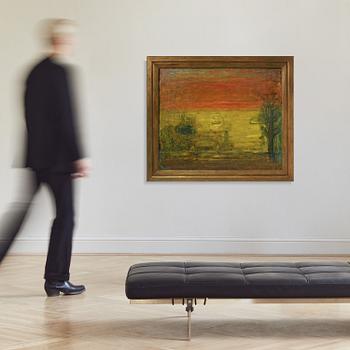Carl Kylberg
”Afton i en stilla vik”.
Signed CK. Also signed verso. Executed ca 1938. Canvas 107 x 129.5 cm. The frame made by the artist's wife, Ruth.
Provenance
Mrs Ruth Kylberg.
Fritzes Konsthandel, Stockholm, 1970.
Uppsala Auktionskammare, International Quality Auction, 3 June, 2008, cat. no. 1487.
Stockholms Auktionsverk, Modern Art & Design, 26 October 2011, lot 722.
Exhibitions
Swedish-French Art Gallery, Stockholm, 1940, cat. no. 45.
Liljevalchs Art Hall, Stockholm, "Carl Kylberg", 20 April - 12 May, 1946, cat. no. 27.
Liljevalchs Art Hall, Stockholm, "Carl Kylberg - Memorial Exhibition", 1954, cat. no. 118.
Malmö Art Hall, 1977, cat. no. 29.
Literature
Brita Knyphausen, "Carl Kylberg", Malmö 1965, listed under no. 210.
More information
Carl Kylberg's seascapes are dreamlike and enigmatic. He expresses the beauty of the sunset, ships on the horizon, a calm sea, a peaceful tranquillity. As a teenager, Carl Kylberg signed on to the school ship Abraham Rydberg, inspired by his older brother Fredrik, who was a sailor and had already travelled on the same ship. The experiences he had during this relatively short period later inspired one of his most famous works, ‘Den flygande holländaren", and some other mysterious ships, which he depicted in an atmosphere of shimmering light and strange darkness. Kylberg himself liked to talk about his existential encounter with the endless sea and the lonely ship when he went to meet the Abraham Rydberg where it was moored on the roadstead outside Sandhamn. He arrived there at dusk and saw the ship lying like a dream on the shiny water in the dying light of summer.
In his paintings, Kylberg sought to express the spiritual, the universal and the universal human. In his diaries, he regularly comments on his paintings and there you can find the key that illuminates his deep-thinking artistry. His scenography contained the ideas of human destiny as a journey, the ship approaching land with the destinies of the people on board or setting off into the great wide sea and meeting an unexpected fate.
Kylberg is difficult to place within any specific artistic ‘-ism’. Vincent van Gogh has had a significant influence on Kylberg's art through his liberating technique. To some extent, Kylberg's work can be compared to William Turner's, as both obviously unite man and nature. A common denominator between Turner and Kylberg is the sun. It is an obvious part of reality and, through its many colour changes, it also becomes a gateway to something deeper and more abstract.
The painting ”Afton i en stilla vik” was painted in 1938. During the 1930s, Kylberg had developed his mature style, with a stronger expression and more intense colours. The subject matter is typical of Kylberg, and many of his seascapes were painted during summer stays in the Danish town of Aalgarde in 1936-37. The frame is a typical bronzed ‘Kylbergram’ (Kyllbergframe), made by his wife Ruth Kylberg, who carved and planed the rustic profile.
Kylberg believed that colour was fundamental to authentic and meaningful painting. He built his pictures with colour, but did not see himself as an expressionist. He distanced himself from the brutal colours and grotesque exaggerations of the expressionists. Instead, he used the world around him and the landscape as a means to reach deeper emotions and communicate with the viewer. As he put it: ‘The essence of painting is nothing but to express what is visible in the soul, not to paint houses and superficial events...’
The composition of ”Afton i en stilla vik” is made up of three horizontal bands of colour. The foreground is a strip of land merging with the sun-drenched sea. A tree on the right side of the picture frames the subject. The horizon line is emphasised by the contrast between the golden sea and the purple sunset. In the mirror-like bay lies a sailing ship, which Brita Knyphausen interprets as symbols of both travel and longing. The sailing ship is at anchor, but can leave at any time, as the sea extends beyond the frame.
Knyphausen quotes Kylberg: ‘[...] a painting should only be a gateway [...] This gateway must be such that it draws and entices further searching.’ To achieve this, Kylberg used techniques such as aerial perspective and broad brushstrokes, with certain strokes of colour floating above others, giving a sense of depth. In this contemplative subject, which carries an almost sacred feel with the sea as a link between earth and sky, we might be tempted to see Kylberg as an escapist. For him, the painterly process was about leading us into a dream world. Kylberg wanted to give the viewer the tools to see beyond the familiar and activate us in our encounter with the image. ‘I cannot waste precious time convincing people of what they already know [...] I want to convince people that the eyes of their soul can also see.’ (Carl Kylberg).
Artist
Carl Kylberg, 1878-1952, is considered a seminal figure in the Swedish 1900-century art. He was a student at the architecture department at Berlin University and then a student of Carl Wilhelmson at Valand art school in Gothenburg.
Kylberg broke through late, made his debut as a painter in 1919 with the February group at Liljevalchs. He became known to a wider public by the age of 50, but continued to be controversial as an artist. He had a permanent artistic antagonist of Isaac Grünewald and the same year as the Nazis in Germany set up the decisive blow against Entartete Kunst and practically the whole of modernism, Swedish government stopped the purchase of the painting "Uppbrottet" of the National Museum in Stockholm.
Read more































































